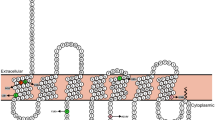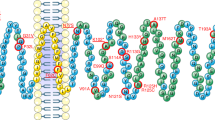Abstract
OBJECTIVE: Mutations in the pro-opiomelanocortin and melanocortin 4 receptor genes (POMC and MC4R) cause monogenic obesity, and the POMC locus (2p21) has been linked to leptin levels and body mass index (BMI). We searched for monogenic obesity due to mutations in POMC and MC4R among morbidly obese Swedes and studied the association of POMC variants with BMI and serum leptin levels.
DESIGN: MC4R and POMC were screened for mutations in 102 obese Swedish subjects (40±11 y, 41.3±5.0 kg/m2) using the single-strand conformation polymorphism technique. The detected polymorphisms were genotyped in 118 lean control subjects (56±11 y, 22.6±1.3 kg/m2) and studied for association with BMI and serum leptin levels.
RESULTS: No cases of monogenic obesity due to mutations in POMC or MC4R were identified and none of the four common POMC polymorphisms (RsaI, ins56, Glu188Gly and C8246T) were associated with obesity. Lean carriers of the C8246T CC-genotype had higher serum leptin levels compared to CT or TT carriers (9.7±6.6 vs 6.7±4.4 μg/l, P=0.003 for leptin levels adjusted for age, sex and BMI in regression analysis), especially lean females (P=0.004) and lean female carriers with the C8246T(CC)/RsaI(−−or +−) genotype combinations (P<0.0005). Neither the C8246T CC-genotype nor the C8246T(CC)/RsaI(−−or +−) were associated with serum leptin levels in obese subjects.
CONCLUSIONS: Monogenic forms of obesity due to mutations in POMC and MC4R are rare in Swedish obese patients. Polymorphisms in POMC are associated with variation in serum leptin levels within the normal range in healthy lean but not in obese individuals.
This is a preview of subscription content, access via your institution
Access options
Subscribe to this journal
Receive 12 print issues and online access
$259.00 per year
only $21.58 per issue
Buy this article
- Purchase on Springer Link
- Instant access to full article PDF
Prices may be subject to local taxes which are calculated during checkout
Similar content being viewed by others
References
Montague CT, Farooqi IS, Whitehead JP, Soos MA, Rau H, Wareham NJ, Sewter CP, Digby JE, Mohammed SN, Hurst JA, Cheetham CH, Earley AR, Barnett AH, Prins JB, O'Rahilly S . Congenital leptin deficiency is associated with severe early-onset obesity in humans. Nature 1997; 387: 903–908.
Strobel A, Issad T, Camoin L, Ozata M, Strosberg AD . A leptin missense mutation associated with hypogonadism and morbid obesity. Nat Genet 1998; 18: 213–215.
Clement K, Vaisse C, Lahlou N, Cabrol S, Pelloux V, Cassuto D, Gourmelen M, Dina C, Chambaz J, Lacorte JM, Basdevant A, Bougneres P, Lebouc Y, Froguel P, Guy-Grand B . A mutation in the human leptin receptor gene causes obesity and pituitary dysfunction. Nature 1998; 392: 398–401.
Krude H, Biebermann H, Luck W, Horn R, Brabant G, Gruters A . Severe early-onset obesity, adrenal insufficiency and red hair pigmentation caused by POMC mutations in humans. Nat Genet 1998; 19: 155–157.
Jackson RS, Creemers JW, Ohagi S, Raffin-Sanson ML, Sanders L, Montague CT, Hutton JC, O'Rahilly S . Obesity and impaired prohormone processing associated with mutations in the human prohormone convertase 1 gene. Nat Genet 1997; 16: 303–306.
Yeo GS, Farooqi IS, Aminian S, Halsall DJ, Stanhope RG, O'Rahilly S . A frameshift mutation in MC4R associated with dominantly inherited human obesity. Nat Genet 1998; 20: 111–122.
Vaisse C, Clement K, Guy-Grand B, Froguel P . A frameshift mutation in human MC4R is associated with a dominant form of obesity. Nat Genet 1998; 20: 113–114.
Hinney A, Schmidt A, Nottebom K, Heibult O, Becker I, Ziegler A, Gerber G, Sina M, Gorg T, Mayer H, Siegfried W, Fichter M, Remschmidt H, Hebebrand J . Several mutations in the melanocortin-4 receptor gene including a nonsense and a frameshift mutation associated with dominantly inherited obesity in humans. J Clin Endocrinol Metab 1999; 84: 1483–1486.
Sina M, Hinney A, Ziegler A, Neupert T, Mayer H, Siegfried W, Blum WF, Remschmidt H, Hebebrand J . Phenotypes in three pedigrees with autosomal dominant obesity caused by haploinsufficiency mutations in the melanocortin-4 receptor gene. Am J Hum Genet 1999; 65: 1501–1507.
Gu W, Tu Z, Kleyn PW, Kissebah A, Duprat L, Lee J, Chin W, Maruti S, Deng N, Fisher SL, Franco LS, Burn P, Yagaloff KA, Nathan J, Heymsfield S, Albu J, Pi-Sunyer FX, Allison DB . Identification and functional analysis of novel human melanocortin-4 receptor variants. Diabetes 1999; 48: 635–639.
Vaisse C, Clement K, Durand E, Hercberg S, Guy-Grand B, Froguel P . Melanocortin-4 receptor mutations are a frequent and heterogeneous cause of morbid obesity. J Clin Invest 2000; 106: 253–262.
Farooqi IS, Yeo GS, Keogh JM, Aminian S, Jebb SA, Butler G, Cheetham T, O'Rahilly S . Dominant and recessive inheritance of morbid obesity associated with melanocortin 4 receptor deficiency. J Clin Invest 2000; 106: 271–279.
Kobayashi H, Ogawa Y, Shintani M, Ebihara K, Shimodahira M, Iwakura T, Hino M, Ishihara T, Ikekubo K, Kurahachi H, Nakao K . A novel homozygous missense mutation of melanocortin-4 receptor (MC4R) in a Japanese woman with severe obesity. Diabetes 2002; 51: 243–246.
Mergen M, Mergen H, Ozata M, Oner R, Oner C . A novel melanocortin 4 receptor (MC4R) gene mutation associated with morbid obesity. J Clin Endocrinol Metab 2001; 86: 3448.
Dubern B, Clement K, Pelloux V, Froguel P, Girardet JP, Guy-Grand B, Tounian P . Mutational analysis of melanocortin-4 receptor, agouti-related protein, and alpha-melanocyte-stimulating hormone genes in severely obese children. J Pediatr 2001; 139: 204–209.
Mercer JG, Hoggard N, Williams LM, Lawrence CB, Hannah LT, Trayhurn P . Localization of leptin receptor mRNA and the long form splice variant (Ob-Rb) in mouse hypothalamus and adjacent brain regions by in situ hybridization. FEBS Lett 1996; 387: 113–116.
Thornton JE, Cheung CC, Clifton DK, Steiner RA . Regulation of hypothalamic proopiomelanocortin mRNA by leptin in ob/ob mice. Endocrinology 1997; 138: 5063–5066.
Marsh DJ, Hollopeter G, Huszar D, Laufer R, Yagaloff KA, Fisher SL, Burn P, Palmiter RD . Response of melanocortin-4 receptor-deficient mice to anorectic and orexigenic peptides. Nat Genet 1999; 21: 119–122.
Hager J, Dina C, Francke S, Dubois S, Houari M, Vatin V, Vaillant E, Lorentz N, Basdevant A, Clement K, Guy-Grand B, Froguel P . A genome-wide scan for human obesity genes reveals a major susceptibility locus on chromosome 10. Nat Genet 1998; 20: 304–308.
Lee JH, Reed DR, Li WD, Xu W, Joo EJ, Kilker RL, Nanthakumar E, North M, Sakul H, Bell C, Price RA . Genome scan for human obesity and linkage to markers in 20q13. Am J Hum Genet 1999; 64: 196–209.
Ö hman M, Oksanen L, Kaprio J, Koskenvuo M, Mustajoki P, Rissanen A, Salmi J, Kontula K, Peltonen L . Genome-wide scan of obesity in Finnish sibpairs reveals linkage to chromosome Xq24. J Clin Endocrinol Metab 2000; 85: 3183–3190.
Comuzzie AG, Hixson JE, Almasy L, Mitchell BD, Mahaney MC, Dyer TD, Stern MP, MacCluer JW, Blangero J . A major quantitative trait locus determining serum leptin levels and fat mass is located on human chromosome 2. Nat Genet 1997; 15: 273–276.
Hixson JE, Almasy L, Cole S, Birnbaum S, Mitchell BD, Mahaney MC, Stern MP, MacCluer JW, Blangero J, Comuzzie AG . Normal variation in leptin levels is associated with polymorphisms in the proopiomelanocortin gene, POMC. J Clin Endocrinol Metab 1999; 84: 3187–3191.
Echwald SM, Sorensen TI, Andersen T, Tybjaerg-Hansen A, Clausen JO, Pedersen O . Mutational analysis of the proopiomelanocortin gene in Caucasians with early onset obesity. Inte J Obes Relat Metab Disord 1999; 23: 293–298.
Delplanque J, Barat-Houari M, Dina C, Gallina P, Clement K, Guy-Grand B, Vasseur F, Boutin P, Froguel P . Linkage and association studies between the proopiomelanocortin (POMC) gene and obesity in Caucasian families. Diabetologia 2000; 43: 1554–1557.
Rosmond R, Ukkola O, Bouchard C, Bjorntorp P . Polymorphisms in exon 3 of the proopiomelanocortin gene in relation to serum leptin, salivary cortisol, and obesity in Swedish men. Metabolism 2002; 51: 642–644.
O'Brien P, Brown W, Dixon J . Revisional surgery for morbid obesity—conversion to the Lap-Band system. Obes Surg 2000; 10: 557–563.
Vandenplas S, Wiid I, Grobler-Rabie A, Brebner K, Ricketts M, Wallis G, Bester A, Boyd C, Mathew C . Blot hybridisation analysis of genomic DNA. J Med Genet 1984; 21: 164–172.
Klannemark M, Orho M, Langin D, Laurell H, Holm C, Reynisdottir S, Arner P, Groop L . The putative role of the hormone-sensitive lipase gene in the pathogenesis of Type II diabetes mellitus and abdominal obesity. Diabetologia 1998; 41: 1516–1522.
Feder J, Gurling HMD, Darby J, Cavalli-Sforza LL . DNA restriction fragment analysis of the proopiomelanocortin gene in schizophrenia and bipolar disorders. Am J Hum Genet 1985; 37: 286–294.
Hinney A, Becker I, Heibult O, Nottebom K, Schmidt A, Ziegler A, Mayer H, Siegfried W, Blum WF, Remschmidt H, Hebebrand J . Systematic mutation screening of the pro-opiomelanocortin gene: identification of several genetic variants including three different insertions, one nonsense and two missense point mutations in probands of different weight extremes. J Clin Endocrinol Metab 1998; 83: 3737–3741.
Gotoda T, Scott J, Aitman TJ . Molecular screening of the human melanocortin-4 receptor gene: identification of a missense variant showing no association with obesity, plasma glucose, or insulin. Diabetologia 1997; 40: 976–979.
Ohshiro Y, Sanke T, Ueda K, Shimajiri Y, Nakagawa T, Tsunoda K, Nishi M, Sasaki H, Takasu N, Nanjo K . Molecular scanning for mutations in the melanocortin-4 receptor gene in obese/diabetic Japanese. Ann Hum Genet 63: 483–487.
Norman RA, Permana P, Tanizawa Y, Ravussin E . Absence of genetic variation in some obesity candidate genes (GLP1R, ASIP, MC4R, MC5R) among Pima Indians. Int J Obes Relat Metab Disord 1999; 23: 163–165.
Ohshiro Y, Ueda K, Wakasaki H, Kosaka M, Nishi M, Sasaki H, Takasu N, Nanjo K . Sequence analysis of the pro-opiomelanocortin (POMC) gene in obese/diabetic Japanese. Int J Obes Relat Metab Disord 2002; 26: 730–731.
Rotimi CN, Comuzzie AG, Lowe WL, Luke A, Blangero J, Cooper RS . The quantitative trait locus on chromosome 2 for serum leptin levels is confirmed in African Americans. Diabetes 1999; 48: 643–644.
Cowley MA, Smart JL, Rubinstein M, Cerdan MG, Diano S, Horvath TL, Cone RD, Low MJ . Leptin activates anorexigenic POMC neurons through a neural network in the arcuate nucleus. Nature 2001; 411: 480–484.
Cheung CC, Clifton DK, Steiner RA . Proopiomelanocortin neurons are direct targets for leptin in the hypothalamus. Endocrinology 1997; 138: 4489–4492.
Ho G, MacKenzie RG . Functional characterization of mutations in melanocortin-4 receptor associated with human obesity. J Biol Chem 1999; 274: 35816–35822.
Acknowledgements
This work was supported by grants from the The Finnish Cultural Foundation, Lundbergs Foundation, The Swedish Foundation for the Study of Diabetes, the Albert Påhlssons Foundation, Malmö University Hospital, the Anna-Lisa and Sven-Eric Lundgren Foundation, The Novo Nordisk Foundation, Crafoord Foundation, the Swedish Medical Research Council and The European Association for the Study of Diabetes (Sankyo Pharma). MR was partially funded by a Blücher scholarship and partially by the Swedish Medical Research Council. We thank the patients for attending the study and Mrs Malin Svensson and Ms Lena Rosberg for excellent technical assistance.
Author information
Authors and Affiliations
Corresponding author
Rights and permissions
About this article
Cite this article
Suviolahti, E., Ridderstråle, M., Almgren, P. et al. Pro-opiomelanocortin gene is associated with serum leptin levels in lean but not in obese individuals. Int J Obes 27, 1204–1211 (2003). https://doi.org/10.1038/sj.ijo.0802392
Received:
Revised:
Accepted:
Published:
Issue Date:
DOI: https://doi.org/10.1038/sj.ijo.0802392
Keywords
This article is cited by
-
The association of insertions/deletions (INDELs) and variable number tandem repeats (VNTRs) with obesity and its related traits and complications
Journal of Physiological Anthropology (2017)
-
The Human Obesity Gene Map: The 2005 Update
Obesity (2006)
-
A systematic analysis of disease-associated variants in the 3′ regulatory regions of human protein-coding genes II: the importance of mRNA secondary structure in assessing the functionality of 3′ UTR variants
Human Genetics (2006)
-
The Human Obesity Gene Map: The 2004 Update
Obesity Research (2005)



